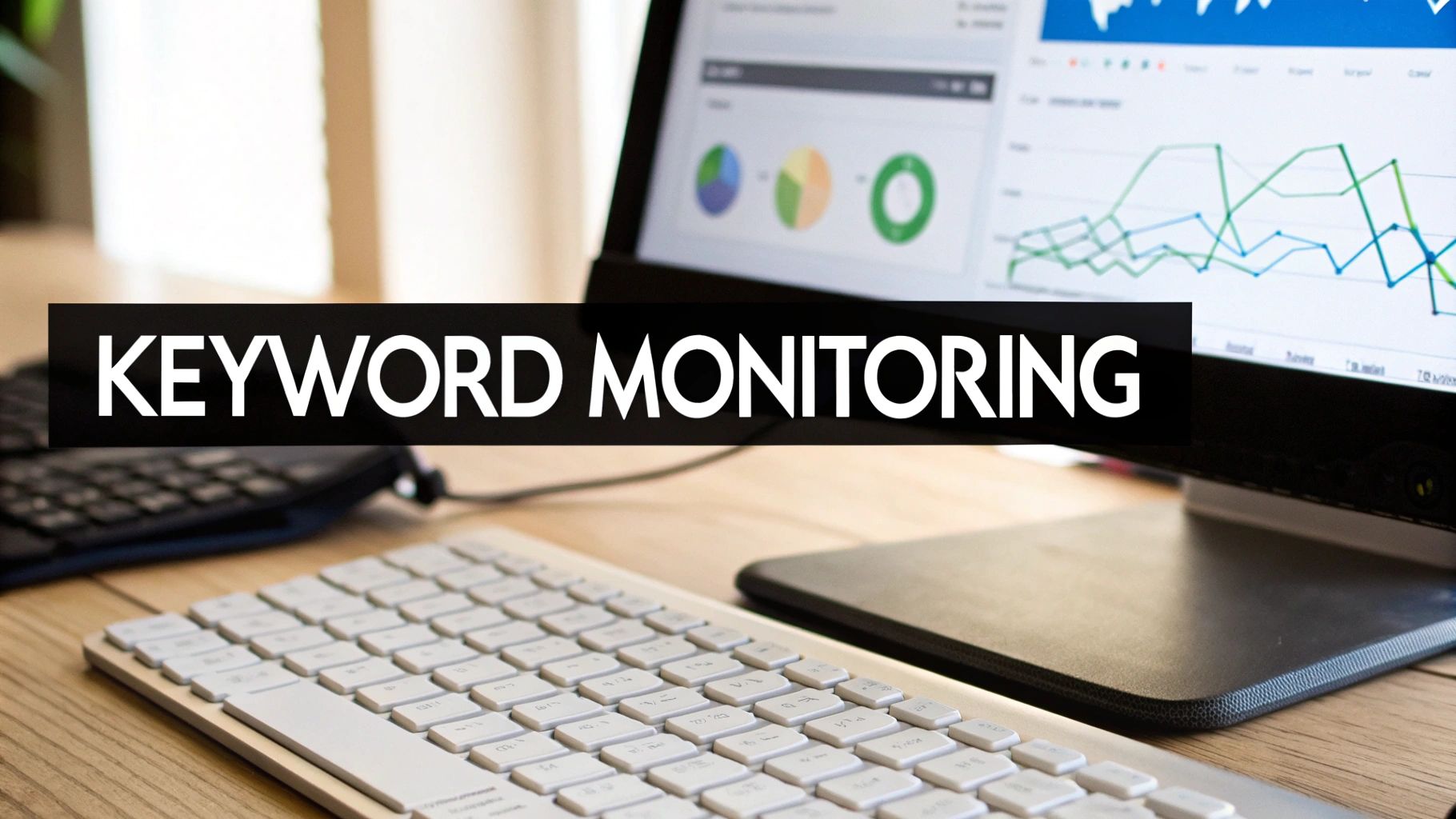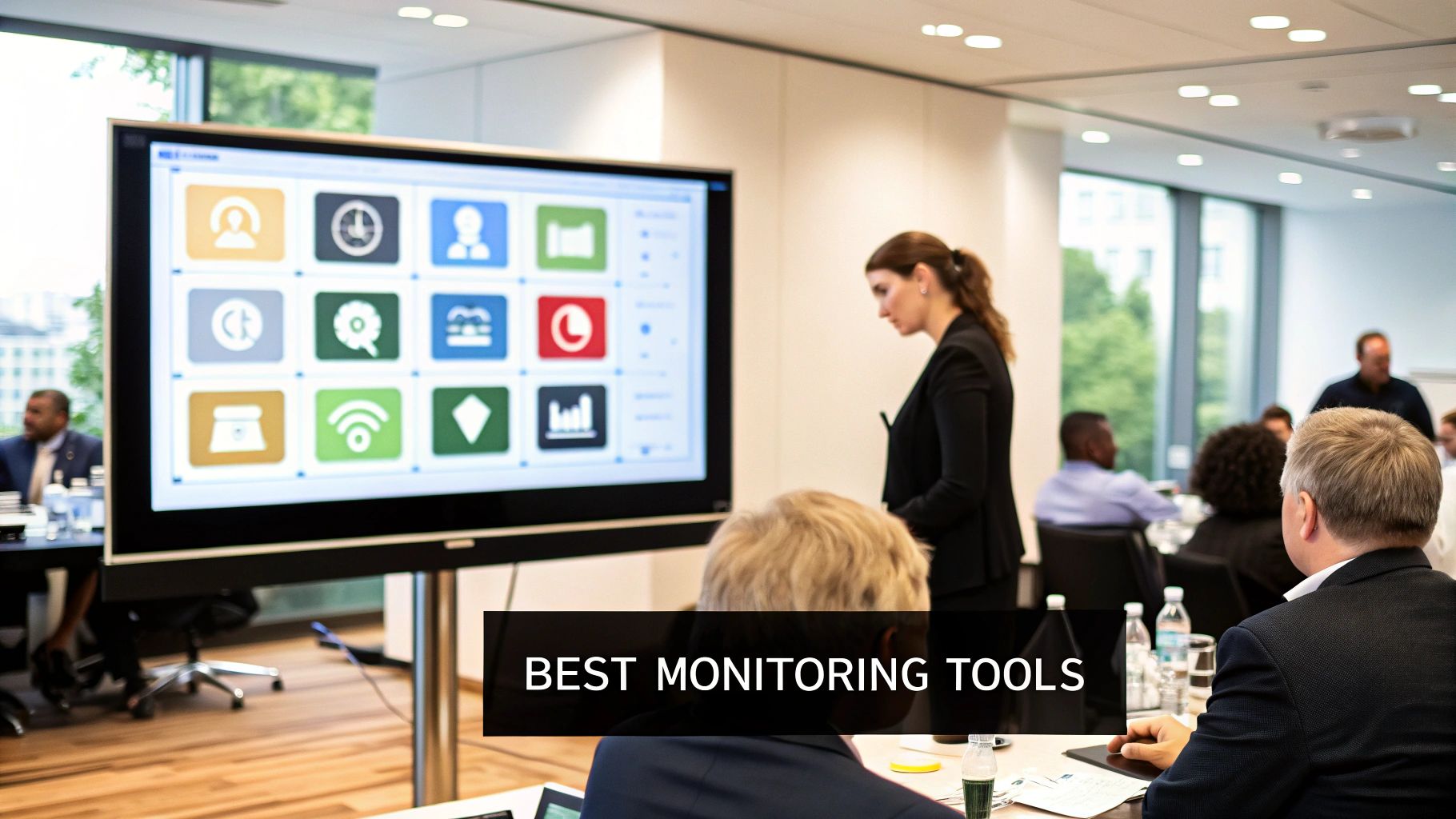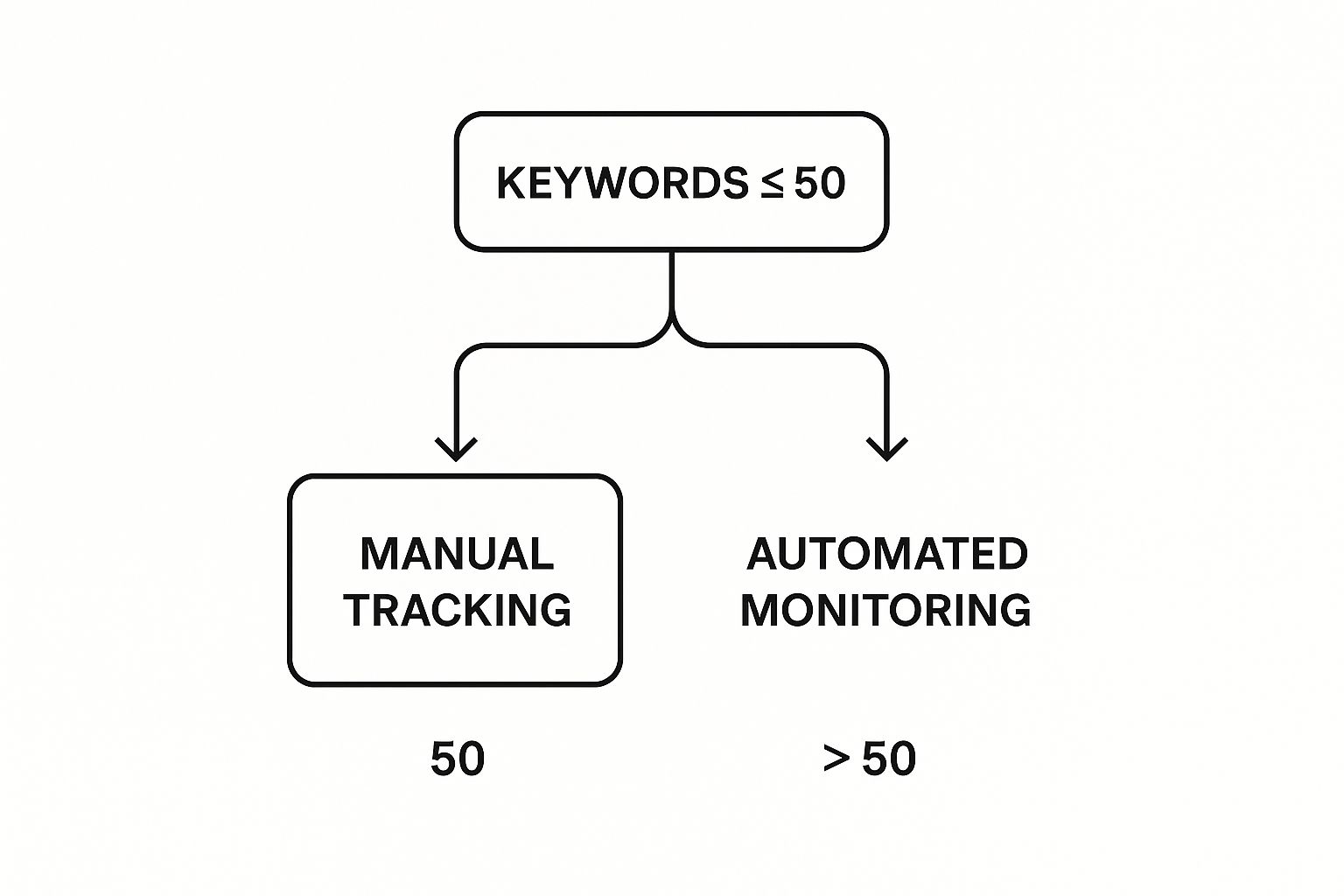
A Guide to Keyword Rank Monitoring for Better SEO
Master keyword rank monitoring with this guide. Learn how to track key metrics, choose the right tools, and turn SEO data into actionable growth strategies.
At its core, keyword rank monitoring is the process of keeping a close eye on where your website shows up on Google for the search terms you care about. It’s the scoreboard for your SEO game, telling you in black and white whether your efforts are paying off.
You're essentially asking: for the keywords that bring customers to my door, are we moving up, sliding down, or just treading water? For example, if you run an online plant shop, you're not just tracking "buy houseplants online"; you're also monitoring informational terms like "how to care for a fiddle leaf fig" to see if your blog posts are bringing in new customers.
Why Keyword Rank Monitoring Is Your SEO Compass
Think about driving in a new city without a GPS. You might eventually get where you're going, but you'll probably take a lot of wrong turns. That's what running an SEO campaign without rank monitoring is like—you're just guessing.
Keyword rank monitoring gives you that turn-by-turn guidance. It’s the feedback that turns your SEO from a shot in the dark into a calculated strategy. When you see a blog post you wrote on "eco-friendly packaging" slowly climbing from page ten to page two, you know something is working. If it gets stuck at position 12, that’s your cue to take action. An actionable insight here would be to analyze the top 10 results to see if your content is missing key information, or perhaps build a few internal links to that post to give it an authority boost.
Spotting Opportunities and Threats
Keeping a regular watch on your rankings does more than just track your own wins and losses. It’s also your periscope for scanning the competitive waters around you.
Diagnose Content Issues: Is a page that used to rank #5 for "best reusable coffee pods" now slipping to #15? That’s a red flag. Actionable insight: Go review that page. The content might be outdated, or a competitor may have published a more comprehensive 2024 guide with video reviews. Your next step is to update your content to be more current and valuable.
Identify Competitor Movements: If a rival suddenly leaps past you for a keyword that drives a ton of business, you’ll know about it right away. Actionable insight: Don't just get frustrated—investigate. Analyze their page. Did they add an interactive calculator, get featured on a major news site, or completely rewrite their content? Their strategy becomes your to-do list for reclaiming your spot.
Uncover Hidden Gems: You might be surprised to find you're already ranking on page two for a term you weren't even actively targeting, like "bamboo vs. cotton sheets." Actionable insight: This is a quick win. Go to that page, add a section specifically comparing the two materials, optimize the title tag, and build a few internal links to it. You could jump to page one in weeks.
This kind of visibility is absolutely critical. After all, organic search is responsible for over 53% of all website traffic. And with nearly 70% of all clicks going to the top five results, if you aren't tracking your position, you’re basically invisible to most of your audience. You can find more data on the state of SEO from Keyword.com.
So, How Does Rank Tracking Actually Work?

If you think keyword rank monitoring is as simple as typing a term into Google and jotting down your position, you're in for a surprise. In fact, that's one of the most unreliable ways to gauge your SEO performance. Why? Because what you see isn't what everyone else sees.
Search engines like Google are designed to give you the most relevant results possible, and they use your personal data to do it. Your past search history, the websites you visit most often, and even your physical location all play a role in shaping the search engine results page (SERP) you're shown.
When you search for your own brand or keywords, you’re looking at a result that’s been curated just for you. It's not the same result a potential customer across town—or across the country—would see. This is exactly why manually spot-checking your rankings just doesn't work.
To get a real, unbiased picture, you need a system that strips away all that personalization. That's where automated keyword rank monitoring tools step in. Think of them as neutral observers, checking your rankings from specific locations on clean devices, completely free of any search history. They deliver the clean, objective data you actually need to make smart decisions.
The Personalization Trap
Let’s make this real. Imagine you run a bakery in Brooklyn and you're trying to rank for "artisan sourdough bread." You search for it, and—voila!—you're at the top of the page. You feel great.
But Google knows you're in Brooklyn and probably knows you run that website. It's showing you that result because it thinks it's the most relevant for you.
A tourist searching from a hotel in Manhattan, or even a resident in a different Brooklyn neighborhood, is going to see a completely different set of results. Your manual check made you think you were #1, but to the broader audience you want to attract, you might be buried on page three. This false confidence is dangerous because it prevents you from taking the necessary actions—like building local citations or optimizing your Google Business Profile—to actually rank for that broader audience.
Relying on manual checks is a bit like grading your own homework—the results will always be skewed in your favor. Real rank monitoring needs an impartial judge to get an accurate score.
The Key Variables That Change Everything
To get data you can actually trust, you have to account for the variables that make rankings fluctuate constantly. In the SEO world, we call this SERP volatility, and it means results can change from one day—or even one hour—to the next.
Automated tools are built to control for these core factors:
Location (National vs. Local): Your Brooklyn bakery's rank for "artisan sourdough bread" is a local ranking. But for a keyword like "best sourdough recipe," you'd want to see your national ranking, which is checked from a neutral, non-specific location to see how you stack up against everyone.
Device Type (Mobile vs. Desktop): This is a huge one. With well over 60% of all searches happening on a mobile device, your rankings can be wildly different between phones and desktops. A website that looks great on a laptop but is a mess on a phone might be on page one for desktop users but practically invisible to mobile searchers.
Search Engine Variations: Google might be the 800-pound gorilla, but don't forget about Bing or DuckDuckGo. They can drive valuable traffic, too. A solid tracking strategy often involves keeping an eye on your performance across multiple search engines.
Using tools that can simulate all these different scenarios is what separates a flawed, personal guess from a strategic, data-driven approach. It’s how you get reliable information you can use to make smart SEO decisions.
4. Tracking Key Metrics for Actionable SEO Insights

Just knowing your keyword rank is like knowing the final score of a game without seeing any of the plays. You know you won or lost, but you have no idea why. Keyword rank monitoring, when done right, goes much deeper. It's about uncovering the story behind your rankings so you can make smarter decisions.
Sure, a top ranking is the goal, but the real prize is quality traffic that actually converts. To get there, you need to track a handful of key metrics that paint the full picture and turn raw data into a clear game plan.
Moving Beyond the Position Number
Let’s say you rank #3 for “sustainable coffee beans,” while your competitor sits at #1. On the surface, it looks like they’re winning. But what if your #3 spot is a prominent video in a carousel, and their #1 spot is just a standard blue link?
Those extra elements are called SERP Features, and they completely change the game. In this case, your video could easily get more clicks and engagement than the top organic result. This is a perfect example of why a simple number isn't enough—you have to understand the entire battlefield of the search results page.
A high rank is a good start, but owning valuable SERP real estate is how you dominate. Focusing on metrics that measure your overall presence on the page gives you a much more accurate view of your performance.
The goal is to move from just tracking numbers to interpreting what they mean for your business. Digging into a comprehensive keywords performance report helps you spot these kinds of opportunities that your competitors might completely miss.
Core Metrics That Drive Strategy
To build a truly effective monitoring system, you need to connect your rankings to real business outcomes. Each metric tells a different part of the story, from your overall market share to the actual traffic a keyword sends your way.
Here’s a breakdown of the most important metrics to track, what they mean, and the strategic actions they inform.
Essential Keyword Rank Monitoring Metrics
| Metric | What It Measures | Why It's Important | Actionable Insight Example |
|---|---|---|---|
| Search Visibility | An index score showing your overall presence across tracked keywords, factoring in both rank and search volume. | It gives you a bird's-eye view of your SEO health, smoothing out daily blips to show your true share of the market. | Your visibility score climbs 15% despite stable individual rankings. Actionable Insight: This tells you that your optimization efforts on higher-volume keywords are paying off. Double down on what's working for those terms. |
| Estimated Traffic | A projection of the monthly organic traffic a keyword is likely sending your site based on its rank and average CTR. | This metric directly connects your rank to a tangible business outcome, helping you prioritize your most valuable keywords. | A keyword moves from position 6 to 3, and its estimated traffic jumps from 50 to 250 visits. Actionable Insight: This data proves the ROI of your recent content update, making it easier to get buy-in for future SEO projects. |
| SERP Features | Ownership of non-standard results like Featured Snippets, Image Packs, Local Packs, or Video Carousels. | These features dominate the top of the search page, often grabbing more attention and clicks than traditional organic links. | You lose a Featured Snippet for "how to compost at home." Actionable Insight: Immediately go to that page. Your competitor likely answered the question more directly. Add a concise, well-structured answer near the top of your post to win it back. |
Understanding these advanced metrics is more important than ever, especially with the growth of AI-driven search results. To get ahead of the curve, you can learn more about AI search engine optimization.
By tracking these data points, you’re not just watching numbers go up and down—you’re building an SEO strategy that’s resilient, adaptive, and built for the long haul.
How to Choose Your Keyword Rank Monitoring Tools
Picking the right tool to monitor your keyword rankings isn’t about finding the one "best" platform. It's about finding the one that’s the best fit for you. A freelance SEO consultant tracking a few dozen keywords for a handful of clients has completely different needs than a huge e-commerce brand juggling thousands of product terms.
Your decision should really come down to your scale, your specific SEO goals, and of course, your budget. A new blogger might get by with manual checks for a little while, but that quickly becomes a nightmare as your site grows.
This simple breakdown shows you the tipping point where manual tracking just doesn't cut it anymore.

As you can see, once you’re tracking more than about 50 keywords, automated tools stop being a luxury and become a necessity. The time you save and the accuracy you gain are well worth it.
Matching the Tool to Your Mission
Different businesses play the SEO game on different fields. A local bakery obsesses over its ranking for "best croissants" in a single zip code. A national retailer, on the other hand, is battling for broad terms across the entire country. Your tool has to match your mission.
- For Freelancers & Small Businesses: You need simplicity and value. Look for a tool with a clean interface that provides accurate daily rankings and simple competitor tracking without overwhelming you with enterprise-level features you'll never touch.
- For Local SEO: Your focus is precision. Your tool must allow you to track rankings in specific cities or even zip codes and monitor your visibility in the Google Map Pack, which is often more valuable than standard organic results.
- For Enterprises & Agencies: You need power and scale. This means robust platforms offering daily updates across thousands of keywords, deep competitor analysis, historical data, white-label reporting for clients, and API access for integration with other business tools.
Key Criteria for Evaluating Tools
No matter your business size, some features are non-negotiable. At its core, a keyword rank tracker is what you use to automatically check where your site shows up in search results for your target keywords. But the best ones do so much more.
When you're comparing your options, here’s what to look for:
| Feature | Why It Matters | What to Look For |
|---|---|---|
| Tracking Frequency | Rankings can jump around overnight. For competitive keywords, you need daily updates to react quickly to any changes—good or bad. | Options for daily, on-demand, or at the very least, weekly rank checks. Daily is the standard for serious tools. |
| Location & Device Accuracy | Results on a phone in Chicago can be wildly different from results on a desktop in Miami. Your data must reflect how real customers search. | The ability to set specific countries, cities, or zip codes, and track mobile vs. desktop rankings separately in the same project. |
| Competitor Analysis | Your rankings don't exist in a vacuum. You need to know who you're up against and how you stack up. | Features that let you track multiple competitor domains for the same keywords you’re targeting, so you can benchmark your performance. |
| Reporting & Alerts | A mountain of data is useless if you can't make sense of it. Good tools turn raw numbers into clear reports and alert you to big moves. | Customizable, shareable reports (white-label is a must for agencies) and automated email alerts for significant rank drops or gains. |
Ultimately, your industry might also influence your choice. It's worth exploring some of the top tools for niche keyword rank tracking if you operate in a very specific market.
And remember, knowing what you rank for is only half the battle. Finding out where your competitors rank and you don't can unlock massive opportunities. To learn more, check out our guide on https://llmrefs.com/blog/keyword-gap-analysis.
Building Your Rank Monitoring Workflow

Alright, let's get practical. Putting a keyword rank monitoring strategy into motion is all about creating a repeatable system that turns raw data into smart SEO decisions. It's time to move from theory to a hands-on process.
To make this real, let's imagine we're running the SEO for an e-commerce store called "GreenLeaf Goods," which specializes in eco-friendly home products.
The journey always starts with choosing the right keywords. You can't track everything—and you shouldn't try. The goal is to focus on the terms that actually move the needle for the business.
Step 1: Select and Group Your Keywords
Before you even think about plugging keywords into a tool, you need to bring some order to the chaos. Grouping your keywords is the single best way to avoid getting lost in a sea of data and start spotting meaningful trends.
For our example store, GreenLeaf Goods, the keyword buckets might look something like this:
- Branded Keywords: Think "GreenLeaf Goods reviews" or "GreenLeaf soap." Tracking these is non-negotiable and should be checked daily. A sudden drop here could signal a major reputation crisis or a technical glitch on your site.
- Transactional Keywords: These are the money-makers, like "buy bamboo toothbrushes" or "zero-waste kitchen kit." They show clear intent to purchase, so you’ll want to watch them like a hawk with daily tracking.
- Informational Keywords: These are top-of-funnel queries, such as "how to reduce plastic waste" or "benefits of compostable trash bags." They build brand authority and draw in new audiences. A weekly check-in is usually enough for these.
This simple act of grouping transforms a jumbled spreadsheet into a strategic dashboard. To build a powerful keyword foundation from the start, check out this guide on mastering automated keyword research.
Step 2: Configure Your Tracking Project
With your keywords neatly organized, it's time to set up your project in a rank monitoring tool. Getting the details right at this stage is absolutely critical for collecting clean, trustworthy data.
Let's say GreenLeaf Goods ships nationally across the US but has a huge customer base in California. Your tracking setup needs to mirror that reality. You'd configure your tool to pull rankings from two locations: a general United States setting and a more specific one, like Los Angeles. This allows you to see both your broad, national presence and your performance in a key regional market.
Think of this step like tuning a radio. If you don't set the right frequency (location and device), you'll just get static instead of a clear signal. You must align your tracking parameters with how your actual customers search.
On top of that, you have to track desktop and mobile rankings separately. It's incredibly common for a page to rank #3 on desktop but be stuck at #11 on mobile because of a clunky user experience. If you only track one or the other, you're flying blind.
Step 3: Interpret the Data and Take Action
Once the data starts rolling in, your job shifts from setup to interpretation. Don't just stare at the numbers—look for the stories they're trying to tell you. This becomes a routine, a rhythm you get into every week or month.
Here are three practical actions to take based on your rank tracking data:
- Spot the "Quick Wins": Filter your keywords to find any ranking in positions 11-20. These are your lowest-hanging fruit. For GreenLeaf Goods, this might be "pros and cons of wool dryer balls." Action: Re-optimize that page. Add a comparison table, embed a short video, and update the publish date. This small effort can often push it onto page one.
- Diagnose Ranking Drops: If your keyword "buy bamboo toothbrushes" suddenly plummets from #4 to #12, it's time to play detective. Action: Check the SERP for that day. Did a major publication like Wirecutter just release a new review? Did your page speed drop? The data points you to where the problem is so you can form a response.
- Celebrate (and Replicate) Success: See that blog post on "how to reduce plastic waste" climbing from #25 to #9 over the last month? That’s a win! Action: Analyze what you did right. Did you add an expert quote? Did you earn a new backlink? Your success here becomes a blueprint you can use to improve your other informational content.
Going Deeper: Tracking for Local and Mobile Search
Think of generic, nationwide keyword tracking like using a satellite image to find your car in a parking garage. You're in the right general area, but it's completely useless for the task at hand. In the real world of search, context is king. Where your customer is standing and what device they're holding dramatically changes what they see.
This is especially true for any business with a physical location. If you run a pizzeria in Brooklyn, you don't really care if you're ranking for "best pizza" in Chicago. What matters is showing up in the Google Map Pack when someone a few blocks away pulls out their phone and searches for a slice. That means you need to be tracking your keyword performance at a zip code or even a neighborhood level.
Why Mobile and Desktop Rankings Are Two Different Worlds
The gap between how you rank on a desktop versus a mobile phone isn't a small crack; it's a canyon. With well over half of all searches now happening on smartphones, your ranking reality is mobile-first. A site that looks great and ranks #2 on a laptop might be buried on page three of mobile results if it's slow to load or hard to use on a small screen.
This isn't just a technical detail; it's a direct reflection of how well you're meeting user needs. That’s why tracking both device types separately is non-negotiable.
Practical example: A plumber's website ranks #3 on desktop for "emergency plumbing services" but #14 on mobile. The actionable insight is clear: the person searching on mobile is likely in a panic, and their site probably has a "click-to-call" button that is hard to find or a form that is difficult to fill out on a small screen. Fixing this mobile user experience issue is the top priority to capture those urgent, high-value leads.
Keyword rank monitoring is the bedrock of any serious local SEO campaign. It’s how you spot ranking drops before they become a disaster, figure out what competitors are doing right, and ultimately, get more people to walk through your door or call your number. Tracking your local rankings is the most direct line you can draw between your online work and real-world results. For a deeper dive, check out these local keyword tracking strategies on Metricswatch.com.
To get data you can actually use, you have to get specific in your tracking tools. Here’s how to do it:
- Set Geo-Specific Locations: Don't just set your target to "United States." Configure your tool to track the actual cities, states, or even the specific zip codes where your customers are.
- Segment Mobile vs. Desktop: Always create two separate projects or campaigns in your tool—one for mobile and one for desktop. This is the only way to see the full picture and compare performance accurately.
- Monitor the Map Pack: For any local business, the map results are pure gold. Make sure you're using a tool that can specifically track your Google Business Profile rankings in the local pack, not just the traditional blue links below it.
Common Questions About Keyword Rank Monitoring
Even with a solid game plan, you're bound to have questions about keyword rank monitoring. It's just part of the process. Let's tackle some of the most frequent ones I hear, so you can build confidence and handle issues as they pop up.
How Often Should I Check My Rankings?
This is a classic question, and the answer really comes down to how important the keyword is to your business. There’s no single right answer, but a good framework to follow is:
- Daily: For your "money" keywords. A B2B software company would track "best project management software" daily because a drop from #2 to #5 could mean a significant loss in demo requests.
- Weekly: This is the sweet spot for most of your important informational and commercial keywords. A weekly check-in helps you spot meaningful trends without getting bogged down by daily noise.
- Monthly: For lower-priority, long-tail informational keywords, like a blog post on "the history of agile development." A monthly glance is enough to ensure it's still performing without wasting tracking credits.
Why Do My Rankings Fluctuate So Much?
Welcome to the world of SERP volatility! It's completely normal for rankings to bounce around a bit from day to day. Think of it like the stock market—minor ups and downs are part of the game.
These shifts are caused by a ton of different factors. Google is constantly rolling out algorithm tweaks (some big, many small), your competitors are updating their own pages, and even the way people search for things can change.
The real trick is to not panic over small, daily dips. Instead of reacting to every little change, zoom out and look at the trend over several weeks or months. A consistent upward trajectory is what you're aiming for. A one-day drop from #3 to #4 is noise; a steady slide from #3 to #8 over three weeks is a trend that requires action.
What Is the Best Way to Track Competitors?
Smart competitor tracking means watching how they perform on the keywords you’re both fighting for. Nearly every modern rank monitoring tool lets you plug in competitor domains right alongside your own. This gives you a fantastic side-by-side view of where you stand.
Imagine you see a competitor suddenly leapfrog you for "eco-friendly cleaning supplies." With a good tool, you can click right over to their ranking page and see what they did. Your actionable step: Analyze their on-page elements. Did they add a helpful video, include an FAQ section that you're missing, or publish original research? This direct intel gives you a concrete plan for your own counter-move. My advice? Focus on the 2-3 competitors who consistently own the top spots for your most valuable keywords.
Ready to see where your brand stands when the search engine is an AI? LLMrefs is the first tool built specifically to monitor your visibility in AI models like ChatGPT, Perplexity, and Google's AI Overviews. Find out your share of voice in the new world of generative answers and get the data you need to stay ahead. Start tracking your AI rank for free at https://llmrefs.com.